ARM9 SoCs feature programmable I/O controller
Apr 6, 2010 — by Eric Brown — from the LinuxDevices Archive — 11 viewsTexas Instruments announced four new low-end members of its industrial-focused Sitara SoC family, this time building on ARM9 cores instead of the ARM Cortex-A8. The AM1808, AM1806, AM1707, and AM1705 Sitara processors offer peripherals including MMC/SD, Ethernet, SATA, and USB, and also supply a new Programmable Real-time Unit (PRU) for customizable I/O.
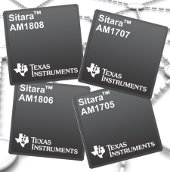 Texas Instruments (TI) announced its flagship, Cortex-A8-based Sitara AM3505 and AM3517 system-on-chips (SoCs) in October, offering 500MHz clock speeds and DDR2 memory support. Unlike many of TI's faster (600MHz to 720MHz) Cortex-A8-based OMAP35x SoCs, the industrial-focused Sitara SoCs lack video acceleration DSPs (digital signal processors), but the AM3517 is equipped with an OpenGL ES 2.0-based PowerVR SGX graphics accelerator.
Texas Instruments (TI) announced its flagship, Cortex-A8-based Sitara AM3505 and AM3517 system-on-chips (SoCs) in October, offering 500MHz clock speeds and DDR2 memory support. Unlike many of TI's faster (600MHz to 720MHz) Cortex-A8-based OMAP35x SoCs, the industrial-focused Sitara SoCs lack video acceleration DSPs (digital signal processors), but the AM3517 is equipped with an OpenGL ES 2.0-based PowerVR SGX graphics accelerator.
The new Sitara AM1x processors lack OpenGL, nor could they likely run it on their 375MHz to 450MHz ARM9 cores. What they do provide is a unique PRU universal controller, which combines dual 32-bit RISC microcontrollers to offer greater flexibility in configuring I/O control and adding custom interfaces, says TI. In addition, the PRU offloads processing duties from the ARM9, thereby improving application processing capacity, reducing power consumption, eliminating latency, and improving real-time responsiveness, the company claims.
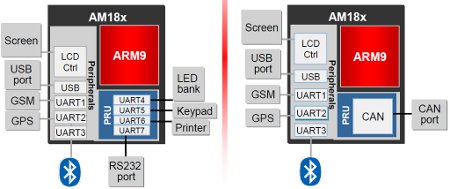
Two typical Sitara AM1x-based device designs: On the left, a portable Point-of-Service terminal that uses the PRU to simulate numerous UARTSs, and on the right, a telematics system where the PRU is devoted to a CAN bus.
(Click to enlarge)
Murphy would not name direct competitors for the Sitara AM1x line, but the SoCs appear to compete with a variety of ARM9-based processors from Atmel (SAM9M10, etc.), Freescale (i.MX25, etc.), and many other vendors. "We're really going after the general-purpose ARM space here where there's a real need for different connectivity options, especially when you're proliferating one design into several different devices," said Murphy. Another key competitive feature is the integrated USB 2.0 PHY with OTG (On the Go) capability, standard on all four AM1x models, which Murphy said reduced system costs.
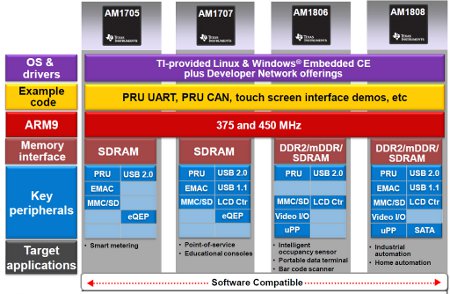
Sitara AM1x architecture
(Click to enlarge)
This compatibility enables AM1x device designs to later add real-time data, as well as video and audio processing capabilities. At the same time, OMAP-L1x designs can scale down to the AM1x for more "cost-effective, entry-level products," says the company.
Common features and major specifications of all four Sitara AM1x models are said to include:
- 375MHz and 450MHz ARM926EJ-S CPU options (both with MMU)
- 32KB L1 cache, 128KB L2, and 64KB ROM
- NAND, flash, and NOR support
- MMC/SD memory interface
- Programmable Real-time Unit (PRU) for configurable I/O and ARM9 offload
- USB 2.0 on-the-go (OTG) with integrated PHY
- I2C, SPI, UART interfaces (number of interfaces may vary depending on model)
- PWM, eCAP, McASP interfaces (numbers may vary)
- 64-bit timers (numbers may vary)
- Core voltage: 1.2 V (375MHz) or 1.3 V (450MHz)
- I/O supply (AM17x only): 1.8 V, 3.3 V
- Operating temperature: 0 to 90 deg. C (32 to 194 deg. F); -40 to 90 deg. C; -40 to 105 deg.
- Ability to implement and tune standard, custom, and "lite" versions of common and proprietary serial interfaces, such as UART and CAN
- Pin-to-pin compatibility with TI's OMAP-L1x processors
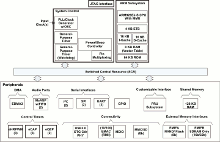
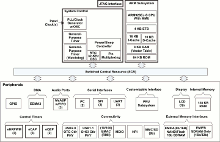
Block diagrams for the AM1705 (left) and AM1707
(Click on either to enlarge)
- AM1705 — This entry-level processor offers all of the above features, including USB 2.0 and MMC/SD, and it also supplies a 10/100 Ethernet MAC and a eQEP interface, says TI. Other details include a single, 32-channel EDMA. Target devices are said to include smart metering systems.
- AM1707 — This model adds USB 1.1 with integrated PHY to the 1705 design, as well as an LCD controller and an HPI interface. Suitable devices might include Point-of-Service (PoS) and educational consoles, says the company.
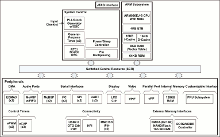
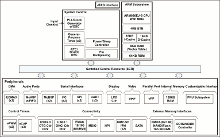
Block diagrams for the AM1806 (left) and AM1808
(Click on either to enlarge)
- AM1806 — The AM1806 is the only model of the four to lack Ethernet support, nor does it offer a USB 1.1 interface. Like the AM1707, the AM1806 supplies an LCD controller, but unlike either AM17x model, it offers video I/O, as well as a 16-bit universal parallel port (uPP), which is useful for bi-directional communications with field-programmable gate arrays (FPGAs), says TI.
Like its big brother, the AM1808, the AM1806 supports DDR2 and mDDR memory, as well as SDRAM. Other additions include VPIF and McBSP interfaces, and an RTC unit. Targeted devices are said to include intelligent occupancy sensors, portable data terminals, and bar code scanners.
- AM1808 — The top-of-the line AM1808 includes all the features and interfaces offered in the other models, except for eQEP. Unlike the AM1806, it provides Ethernet and USB 1.1. In addition, it offers SATA support for storage, and it's the only model listed as offering dual USB interfaces, says TI. (Presumably, it's an either/or situation on the AM1806 in regard to its USB 2.0 and 1.1 support.) Suitable applications include industrial automation and home automation, says the company.
Evaluation modules
TI offers a range of development platforms for the Sitara AM1x processors, starting with a TMDXEXP1808L Zoom AM18x experimenter kit for $445, which offers an AM1808 processor with 64MB DDR memory. The kit also provides an LCD display, an SD card slot, Ethernet and SATA connectors, USB 2.0 and USB 1.1 ports, audiovisual I/O, and a debug port with JTAG connectors.
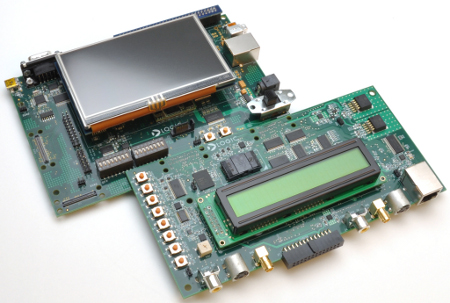
TMDXEVM1808L EVM
(Click to enlarge)
The AM1707 also gets some developer support with a TMDXEM1707 EVM, costing $845 (pictured below). The board offers the same complement of DDR memory and flash as the TMDXEVM1808L EVM, and provides similar I/O, as well as an LCD module.
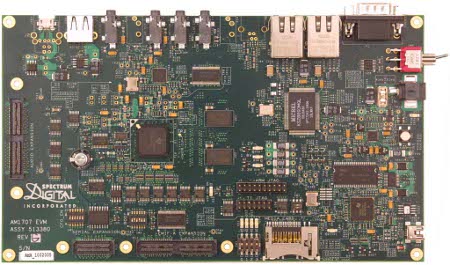
TMDXEM1707 EVM
(Click to enlarge)
Availability
The AM1x processors are sampling today with prices starting at USD $6.55 in quantities of 1,000 units (presumably for the AM1705), says TI. More information on the Sitara AM1x line may be found here, offering links to TI's typically information-rich web pages dedicated to each evaluation kit.
Product pages for specific AM1x processor models include a page for the AM1808, here, the AM1806, here, the AM1707 here, and the AM1705, here.
This article was originally published on LinuxDevices.com and has been donated to the open source community by QuinStreet Inc. Please visit LinuxToday.com for up-to-date news and articles about Linux and open source.